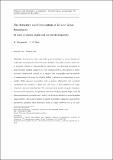The structure and composition of olivine grain boundaries: 40 years of studies, status and current developments
Author(s)
Marquardt, K.; Faul, U. H
Download269_2017_935_ReferencePDF.pdf (14.94Mb)
Publisher Policy
Publisher Policy
Article is made available in accordance with the publisher's policy and may be subject to US copyright law. Please refer to the publisher's site for terms of use.
Terms of use
Metadata
Show full item recordAbstract
Abstract
Interfaces in rocks, especially grain boundaries in olivine dominated rocks, have been subject to about 40 years of studies. The grain boundary structure to property relation is fundamental to understand the diverging properties of polycrystalline samples compared to those of single crystals. The number of direct structural observations is small, i.e. in range of 100 micrographs, and the number of measurements of properties directly linked to structural observations is even smaller. Bulk aggregate properties, such as seismic attenuation, rheology and electrical conductivity, are sensitive to grain size, and seem to show influences by grain boundary character distributions. In this context we review previous studies on grain boundary structure and composition and plausible relations to bulk properties. The grain boundary geometry is described using five independent parameters; generally, their structural width ranges between 0.4–1.2 nm and the commonly used 1 nm seems a good approximation. This region of enhanced disorder is often enriched in elements that are incompatible in the perfect crystal lattice. The chemical composition of grain boundaries depends on the bulk rock composition. We determined the 5 parameter grain boundary character distribution (GBCD) for polycrystaline Fo
$$_{90}$$
90
and studied structure and chemistry at the nm-scale to extend previous measurements. We find that grain boundary planes close to perpendicular to the crystallographic c-direction dominate the grain boundary network. We conclude that linking grain boundary structure in its full geometric parameter space to variations of bulk rock properties is now possible by GBCD determination using EBSD mapping and statistical analyses.
Date issued
2018-01-30Department
Massachusetts Institute of Technology. Department of MathematicsPublisher
Springer Berlin Heidelberg